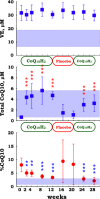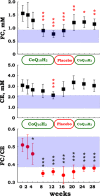Increased oxidative stress and coenzyme Q10 deficiency in juvenile fibromyalgia: amelioration of hypercholesterolemia and fatigue by ubiquinol-10 supplementation
- PMID: 23394493
- PMCID: PMC6837523
- DOI: 10.1179/1351000212Y.0000000036
Increased oxidative stress and coenzyme Q10 deficiency in juvenile fibromyalgia: amelioration of hypercholesterolemia and fatigue by ubiquinol-10 supplementation
Abstract
Fibromyalgia (FM) is characterized by generalized pain and chronic fatigue of unknown etiology. To evaluate the role of oxidative stress in this disorder, we measured plasma levels of ubiquinone-10, ubiquinol-10, free cholesterol (FC), cholesterol esters (CE), and free fatty acids (FFA) in patients with juvenile FM (n=10) and in healthy control subjects (n=67). Levels of FC and CE were significantly increased in juvenile FM as compared with controls, suggesting the presence of hypercholesterolemia in this disease. However, plasma level of ubiquinol-10 was significantly decreased and the ratio of ubiquinone-10 to total coenzyme Q10 (%CoQ10) was significantly increased in juvenile FM relative to healthy controls, suggesting that FM is associated with coenzyme Q10 deficiency and increased oxidative stress. Moreover, plasma level of FFA was significantly higher and the content of polyunsaturated fatty acids (PUFA) in total FFA was significantly lower in FM than in controls, suggesting increased tissue oxidative damage in juvenile FM. Interestingly, the content of monoenoic acids, such as oleic and palmitoleic acids, was significantly increased in FM relative to controls, probably to compensate for the loss of PUFA. Next, we examined the effect of ubiquinol-10 supplementation (100 mg/day for 12 weeks) in FM patients. This resulted in an increase in coenzyme Q10 levels and a decrease in %CoQ10. No changes were observed in FFA levels or their composition. However, plasma levels of FC and CE significantly decreased and the ratio of FC to CE also significantly decreased, suggesting that ubiquinol-10 supplementation improved cholesterol metabolism. Ubiquinol-10 supplementation also improved chronic fatigue scores as measured by the Chalder Fatigue Scale.
Figures








Similar articles
-
Effect of Coenzyme Q10 supplementation on mitochondrial electron transport chain activity and mitochondrial oxidative stress in Coenzyme Q10 deficient human neuronal cells.Int J Biochem Cell Biol. 2014 May;50:60-3. doi: 10.1016/j.biocel.2014.02.003. Epub 2014 Feb 15. Int J Biochem Cell Biol. 2014. PMID: 24534273
-
Ubiquinol-10 ameliorates mitochondrial encephalopathy associated with CoQ deficiency.Biochim Biophys Acta. 2014 Jul;1842(7):893-901. doi: 10.1016/j.bbadis.2014.02.008. Epub 2014 Feb 24. Biochim Biophys Acta. 2014. PMID: 24576561
-
Oral coenzyme Q10 supplementation improves clinical symptoms and recovers pathologic alterations in blood mononuclear cells in a fibromyalgia patient.Nutrition. 2012 Nov-Dec;28(11-12):1200-3. doi: 10.1016/j.nut.2012.03.018. Epub 2012 Aug 14. Nutrition. 2012. PMID: 22898267
-
Effect of coenzyme Q10 evaluated by 1990 and 2010 ACR Diagnostic Criteria for Fibromyalgia and SCL-90-R: four case reports and literature review.Nutrition. 2013 Nov-Dec;29(11-12):1422-5. doi: 10.1016/j.nut.2013.05.005. Nutrition. 2013. PMID: 24103521 Review.
-
Coenzyme Q10 supplementation - In ageing and disease.Mech Ageing Dev. 2021 Jul;197:111521. doi: 10.1016/j.mad.2021.111521. Epub 2021 Jun 12. Mech Ageing Dev. 2021. PMID: 34129891 Review.
Cited by
-
Coenzyme Q10: Clinical Applications beyond Cardiovascular Diseases.Nutrients. 2021 May 17;13(5):1697. doi: 10.3390/nu13051697. Nutrients. 2021. PMID: 34067632 Free PMC article. Review.
-
Miso Soup Consumption Enhances the Bioavailability of the Reduced Form of Supplemental Coenzyme Q10.J Nutr Metab. 2020 Jan 7;2020:5349086. doi: 10.1155/2020/5349086. eCollection 2020. J Nutr Metab. 2020. PMID: 31998536 Free PMC article.
-
Increased oxidative stress in patients with amyotrophic lateral sclerosis and the effect of edaravone administration.Redox Rep. 2016 May;21(3):104-12. doi: 10.1179/1351000215Y.0000000026. Epub 2016 Feb 25. Redox Rep. 2016. PMID: 26191780 Free PMC article. Clinical Trial.
-
Efficacy and safety of fermented Prunus mume vinegar on fatigue improvement in adults with unexplained fatigue: A randomized controlled trial.Front Nutr. 2022 Nov 9;9:990418. doi: 10.3389/fnut.2022.990418. eCollection 2022. Front Nutr. 2022. PMID: 36438753 Free PMC article.
-
Whole-Body Vibration Training on Oxidative Stress Markers, Irisin Levels, and Body Composition in Women with Fibromyalgia: A Randomized Controlled Trial.Bioengineering (Basel). 2023 Feb 16;10(2):260. doi: 10.3390/bioengineering10020260. Bioengineering (Basel). 2023. PMID: 36829754 Free PMC article.
References
-
- Wolfe F, Smythe HA, Yunus MB, Bennett RM, Bombardier C, Goldenberg DL. The American College of Rheumatology 1990 Criteria for the classification of fibromyalgia. Report of the Multicenter Criteria Committee. Arthritis Rheum 1990;33:160–72. - PubMed
-
- Anthony KK, Schanberg LE. Juvenile primary fibromyalgia syndrome. Curr Rheumatol Res 2001;3:165–71. - PubMed
-
- Ozgocmen S, Ozyurt H, Sogut S, Akyol O. Current concepts in the pathophysiology of fibromyalgia: the potential role of oxidative stress and nitric oxide. Rheumatol Int 2006;26:585–97. - PubMed
-
- Pieczenik SR, Neustadt J. Mitochondrial dysfunction and molecular pathways of disease. Exp Mol Pathol 2007;83:84–92. - PubMed
Publication types
MeSH terms
Substances
Supplementary concepts
LinkOut - more resources
Full Text Sources
Other Literature Sources
Medical
